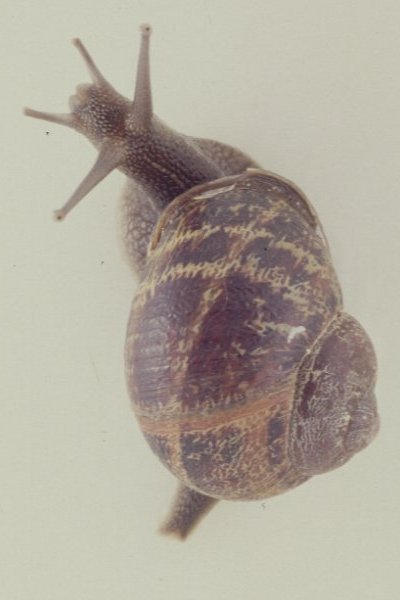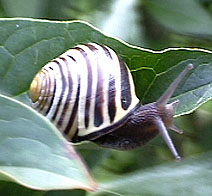| Gastropoda: Pulmonata |
||
| Mollusca | Stylommatophora |
Pulmonata
└─► |
|||
None |
Mollusca |
|
Abbreviated Dendrogram
Gastropoda
├─Caenogastropoda
└─Heterobranchia
├─Opisthobranchia
│
└─Pulmonata
╞═Basommatophora
└─┬─Stylommatophora
└─┬─Systellommatophora
╘═Acteophila
|
Contents
Overview |

Helix aspersa, (Müller, 1774) the common European garden snail. Width and height of shell about 2.5 to 3 cm.
This successful and adaptable species is found throughout Europe, the Middle-East, North and South America and Australia, where it has been introduced and established itself in suburban areas. See Snail Species - the Family Helicidae for more.
(Sigmurethra - Helicoidea - Helicidae - Helicinae]
The higher pulmonates, or Stylommatophora, are a successful clade that far outnumber the Basommatophora in species. This order, the most advanced and specialized of all the pulmonates, includes most land snails and slugs represent one of the major metazoan invasions of the land, comprising some 30,000 to 35,000 species (with many more probably awaiting discovery) - almost equivalent to vertebrates as a whole. They include the familiar garden snail and slug, but also thousands of less known species. They Stylommatophora are major components of many terrestrial ecosystems, and have also become important models for studies on the mechanisms of evolution and biogeographic studies (Wade, iNet). They frequently occur beneath leaf litter, stones and bark, and are especially abundant on oceanic islands, such as the Pacific [Barnes 1980 p.340]. The name "Stylommatophora" means "slender eye-bearing stalk", and refers to the fact that these animals have two pairs of tentacles, with eyes located at the tips of the upper (posterior / dorsal), pair, rather than at the base, as is the case with the Basommatophora. All species are terrestrial, and many are locally abundant. Although most stylommatophores feed on plants and detritus, a few are carnivores that feed on other snails. Chase 2002 p.15

Agathylla biloba (A. J. Wagner 1914)
(Sigmurethra - Clausilioidea - Clausiliidae - Alopiinae]
Photo © V. Wiese, Haus der Natur Cismar, from Albanian non-marine molluscs
Most species have thin to moderately thick calcareous conispiral shells, which range from very low-spired to steep-sided, high-spired forms. A majority have many whorls, generally but not always more than among basommatophorans. [Moore, et al 1952, p.332]. There are also includes shell-less slugs and semi-slugs with residual shells that are too small to accommodate the body. In fact, as with the Opisthobranchia, shell reduction has occurred independently a number of times in different lineages. Slugs seem to have evolved in environments of low calcium and high humidity [Barnes 1980 p.340].
The aperture usually has a rather evenly rounded outer lip, often with a thickened rim. Tooth-like projections of the inner lip, and in some shells of the outer lip also, serve to keep out predators such as insects but allow the soft snail to squeeze through [Barnes 1980 p.340]. . Such features especially characterize genera of the Pupidae, and largely because of the close resemblance of some Pennsylvanian non-marine gastropods to the modern Pupa, these Paleozoic fossils were at one time thought to belong among the stylommatophorans [Moore, et al 1952, p.332]. This is now no longer believed to be the case, and it is generally agreed that the Pulmonates, including the Stylommatophora, evolved much later, during the Jurassic period. [Clarkson, 1979 p.163]
Most Stylommatophora are fairly small, averaging less than a centimeter in shell length or width, although the giant African snail Achatina achatina, have shells that reach 27 cm [Barnes 1980 p.340]
In terms of diversity, they are the largest clade of gastropods, with some 35,000 species, and from 71 to 92 families, depending on the classification scheme used (Bieler, 1992; Wade et al., 2001). Part of this diversity may be due to the fact that local populations easily become isolated, as the animals move slowly, and have little need to migrate. This leads to both greater speciation and greater intraspecific genetic variation [Chase 2002 pp.13-14 ]. According to Thomaz et al., 1996, Cepaea nemoralis has the most extreme intraspecific variation of mitochondrial DNA of any animal.

the European land snail Cepaea nemoralis
(Sigmurethra - Helicoidea - Helicidae - Helicinae]
Earliest Pleistocene to Recent
Width and height of shell about 2 cm.
This very variable European species is found throughout the world. See Snail Species - the Family Helicidae for more.
The monophyletic composition of the Stylommatophora has been confirmed by molecular analysis of ribosomal RNA (Wade & Mordan, 2000, Wade et al., 2001).
The origins and the deep-level evolutionary relationships of their major groupings within the Stylommatophora are controversial, with anatomical studies giving confusing and conflicting results. The following arrangement from Jeffery 2001 (contrast with older classification by Abbott & Dance, 2000) has been modified in the light of molecular research by Chris Wade involving ribosomal RNA gene sequencing. Dr Wade's research reveals a single assemblage including the families Achatinidae, Subulinidae and Streptaxidae near the base of the group, forming a sister group to all remaining stylommatophorans and dividing the order into 'achatinoid' and 'non-achatinoid' taxa. The Orthurethra appear to be relatively advanced within the 'non-achatinoid clade', and broadly equivalent to other super-familial clusters, indicating that supposedly primitive features such as the orthurethran kidney are in fact derived. (Wade, iNet)
I have also modified the Linnaean ranking in keeping with the standard ordinal grade normally given to the Stylommatophora
Although the molecular tree also suggests that the origin of the Stylommatophora is much earlier than the main period of their diversification (Wade, iNet), this may simply (as with the Cambrian explosion and other important events) be a result of evolutionary heterochrony.
page uploaded 24 December 2002
checked ATW051004